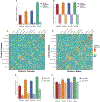Neuroanatomical and functional consequences of oxytocin treatment at birth in prairie voles
- PMID: 36709631
- PMCID: PMC10064488
- DOI: 10.1016/j.psyneuen.2023.106025
Neuroanatomical and functional consequences of oxytocin treatment at birth in prairie voles
Abstract
Birth is a critical period for the developing brain, a time when surging hormone levels help prepare the fetal brain for the tremendous physiological changes it must accomplish upon entry into the 'extrauterine world'. A number of obstetrical conditions warrant manipulations of these hormones at the time of birth, but we know little of their possible consequences on the developing brain. One of the most notable birth signaling hormones is oxytocin, which is administered to roughly 50% of laboring women in the United States prior to / during delivery. Previously, we found evidence for behavioral, epigenetic, and neuroendocrine consequences in adult prairie vole offspring following maternal oxytocin treatment immediately prior to birth. Here, we examined the neurodevelopmental consequences in adult prairie vole offspring following maternal oxytocin treatment prior to birth. Control prairie voles and those exposed to 0.25 mg/kg oxytocin were scanned as adults using anatomical and functional MRI, with neuroanatomy and brain function analyzed as voxel-based morphometry and resting state functional connectivity, respectively. Overall, anatomical differences brought on by oxytocin treatment, while widespread, were generally small, while differences in functional connectivity, particularly among oxytocin-exposed males, were larger. Analyses of functional connectivity based in graph theory revealed that oxytocin-exposed males in particular showed markedly increased connectivity throughout the brain and across several parameters, including closeness and degree. These results are interpreted in the context of the organizational effects of oxytocin exposure in early life and these findings add to a growing literature on how the perinatal brain is sensitive to hormonal manipulations at birth.
Keywords: Birth; Brain; Development; Oxytocin; Prairie vole.
Copyright © 2023 Elsevier Ltd. All rights reserved.
Conflict of interest statement
Conflict of interest CFF reports a financial interest in Animal Imaging Research, the company that makes the radio frequency electronics and holders for animal imaging. All other authors report no biomedical financial interests or potential conflicts of interest.
Figures








References
-
- Allen E, Erhardt E, Damaraju E, Gruner W, Segall J, Silva R, Havlicek M, Rachakonda S, Fries J, Kalyanam R, Michael A, Caprihan A, Turner J, Eichele T, Adelsheim S, Bryan A, Bustillo J, Clark V, Feldstein Ewing S, Filbey F, Ford C, Hutchison K, Jung R, Kiehl K, Kodituwakku P, Komesu Y, Mayer A, Pearlson G, Phillips J, Sadek J, Stevens M, Teuscher U, Thoma R, Calhoun V, 2011. A Baseline for the Multivariate Comparison of Resting-State Networks. Frontiers in Systems Neuroscience 5 - PMC - PubMed
-
- Bales KL, Carter CS, 2003. Developmental exposure to oxytocin facilitates partner preferences in male prairie voles (Microtus ochrogaster). Behav.Neurosci 117, 854–859. - PubMed
-
- Bastian M, Heymann S, Jacomy M, 2009. Gephi: An Open Source Software for Exploring and Manipulating Networks Proceedings of the International AAAI Conference on Web and Social Media 3, 361–362.

